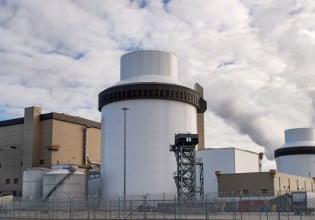Floating Offshore Wind Projects Make Moves
Two floating offshore wind projects make moves in Portugal and Norway.
A 25-megawatt (MW) semi-submersible offshore wind farm in Portugal recently surpassed its production expectations after two years of running. Meanwhile, Norway’s energy authority struck down a legal challenge to a 1-MW vertical-axis wind turbine prototype installation, clearing the way for a new floating wind farm in the North Sea.

Three Vestas turbines encompass a semi-submersible floating offshore wind farm in Portugal. Image used courtesy of EDP Renewables
Here’s a briefing on the projects and their place in the broader floating offshore wind market.
WindFloat Atlantic Offshore Wind Farm Reaches 79 GWh
Nearly 2.5 years after its commissioning in July 2020, Portugal’s WindFloat Atlantic semi-submersible floating offshore wind farm now reports it has exceeded its initial production expectations. The 25-MW site produced 5% more electricity last year than in 2021, ending the year with 78 gigawatt-hours (GWh) of electricity production—enough to serve over 25,000 households and thwart 33,000 tons of carbon dioxide per year. According to its website, this milestone brings the wind farm’s total cumulative output to 180 GWh.
WindFloat Atlantic is situated 11 miles off the coast of Viana do Castelo, in water depths of around 328 feet. It’s hailed as a first-of-its-kind in the industry and the first floating wind power plant in continental Europe, with a semi-submersible floating design anchored to the seabed and three platforms carrying three 8.4-MW wind turbines from Danish manufacturer Vestas.

A close-up look at one of the turbines at the WindFloat Atlantic semi-submersible floating wind farm in Portugal. Image used courtesy of EDP Renewables
The project is owned by Ocean Winds, a Madrid-based company with several floating wind projects in development across Scotland, South Korea, France, the U.S., and the U.K. The firm is a joint venture between French utility giant Engie and Spain’s EDP Renewables, which combined their offshore wind assets and project pipelines in 2019. Spanish petrochemical company Repsol and California wind tech firm Principle Power also have a stake in the project.
Ocean Winds started with 1.5 GW under construction and 4 GW under development but has expanded its portfolio to 16.6 GW of total gross capacity. It’s on track to meet its 2025 target of 5-7 GW of projects in operation or construction and another 5–10 GW undergoing advanced development. Its next floating wind farm is slated to come online in 2024 with 30 MW of installed capacity in the French Mediterranean Sea.
On its website, EDP Renewables touts the cost and accessibility advantages of the floating platform model, such as mounting with conventional cranes on dry land and using common shipping methods rather than costly installation vessels. EDP also says Principle Power’s technology made installing floating platforms possible in wind-abundant deep waters that had previously been untapped.
In an earlier pilot-phase iteration, the developers built and installed a demonstration unit with a 2 MW commercial turbine, the first implementation of the semi-submersible support structure. The platform, dubbed WindFloat 1, operated from 2011 to 2016 with high availability and more than 17 GWh of production, surrounded by 60-knot winds and waves ranging from 23 to 56 feet tall.
Norwegian Floating Wind Project Clears Legal Challenge
An offshore floating wind project in Norway recently received a major win as the country’s regulator, the Norwegian Water Resources and Energy Directorate (NVE), rejected an appeal to overturn its earlier concession (approval) for the developers to install the prototype. The decision comes after the regulator granted a five-year concession last March to install a 1-MW vertical-axis turbine, “dubbed S2x,” with a mooring system and cables. According to the developer, Sweden-based SeaTwirl, the turbine extends about 180 feet above sea level and another 262 feet underwater.
In announcing the appeal rejection in late January, SeaTwirl CEO Peter Laurits stated that the appeals process added uncertainty for a capital-intensive project involving long lead times. The NVE’s decision enabled it to resume the test installation and commercialize its SX line of turbines for floating wind farms.
Video used courtesy of SeaTwirl
The site is located nearly half a mile off the North Sea coast of Boknafjorden in waters as deep as 426 feet. Norway’s Marine Energy Test Centre holds the concession, and the new prototype will be installed at its test facility in Boknafjorden. The project’s budget is about $10.7 million, according to the Swedish Energy Agency (which previously awarded a $4.8 million grant to support it).
SeaTwirl markets vertical-axis wind turbines, an alternative aiming to bypass the limitations and cost challenges of bottom-fixed horizontal-axis wind turbines. According to cost estimates produced for SeaTwirl, the company’s turbines result in a 21% lower levelized cost of energy, on average, than horizontal-axis turbines.
The S2x prototype is a scale-up from SeaTwirl’s first iteration, called “S1.” According to a FAQ page on the company’s website, S2x is about 30 times bigger and provides more capacity than its predecessor, which only had 30 kilowatts of rated power. Having secured regulatory approval to install the 1-MW S2x, SeaTwirl plans to expand to 10 MW eventually.






